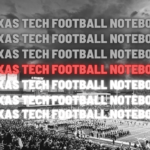I hope you’re enjoying any additional time off that you may have. I’m doing the same and when I have multiple free mornings, I’m able to crank out some solid offseason content. The Morning Stake will return tomorrow.
1. Don’t Settle
Believe it or not, the redzone scoring offense wasn’t that far off from 2018, 87.99% in 2018 and 88.24% in 2019. So yes, technically better, but the huge difference was that the redzone touchdown scoring percentage dropped significantly, from 69% in 2018 to just 54% in 2019. By a lot of traditional metrics, Texas Tech’s offense was similar to last years, yards per play wasn’t that far off, in fact it was actually better, 6.63 YPP in 2019 and 5.88 YPP in 2018. The thing that I think bothers most people is that the passing yards per attempt fell off quite a bit, 7.91 in 2018 (36th in the nation) to 7.34 in 2019 (ranked 72nd). The other significant turnaround was rushing yards per attempt, 3.64 in 2018 (which ranked 113th) to 4.44 in 2019 (63rd)
With Jett Duffey likely moving on, David Yost never took advantage of a guy that could maybe stress a defense into making some bad plays. Yost never really did that and so now, I think that Yost needs to find himself a part of the offseason redzone laboratory and figure out some plays that take advantage of the tight end and the larger receivers that are on this roster. Other than the corner fade. Not only that, but an improved running game should help.
2. Third Downs are Critical
This is a pretty easy one to identify in terms of regression. In 2018, the offense was converting at a very high rate, 47.26% in 2018, which was 13th in the nation, and has fallen to 38.23% in 2019, which is 83rd in the nation. I think that some of this is a reflection of the offense simply not pushing the envelope and Wells’ propensity to be more cautious than daring. Not only that, but Kingsbury was definitely better on a week-to-week basis of creating plays that would gain those critical third downs.
The defense was also a significant problem. In 2018 the defense allowed a 37.49% conversion rate on third downs, 54th in the nation, and has dropped significantly, 41.89% in 2019 which is 91st in the nation. I think that one of Patterson’s key tenets was to force opponents off the field on third downs, but I’d almost guarantee that if we looked at Patterson’s blitz rate, it would be significantly higher on third downs and I think this created some significant advantages for opposing offenses because the pressure wasn’t all that pressing.
3. Running to the End Zone
I mentioned that from an efficiency standpoint, the running game was improved, but from a scoring percentage, Yost dropped off significantly from 2018 to 2019 in rushing touchdowns. In 2018, Texas Tech averaged 2.17 rushing touchdowns, good for 30th in the nation, and then dropped to 1.67 rushing touchdowns a game, down to 62nd in the nation. Defensively, this was also a problem as opponents walked into the endzone at a significantly higher rate. In 2018, opponents ran the ball into the endzone only 1.33 times a game, good for 46th in the nation, and then fell to 2.00 rushing touchdowns a game, dropping to 89th overall.
4. Correlation Between Sacks and Passing Touchdowns?
In 2018, the defense was 50th in sacks, 2.33 per game and that number fell to 2.00, 71st in the nation, in 2019. So the defense, despite what you thought watching the games this year, was actually better in terms of giving up passing touchdowns, in 2018 the defense gave up 2.33 passing touchdowns a game, 122nd in the nation, and improved in 2019, 1.75 passing touchdowns a game good for 78th. So yeah, the defense didn’t get as many sacks, less pressure, and gave up fewer passing touchdowns, but the end result wasn’t any different from a scoring percentage. In 2018, the defense gave up 2.33 passing touchdowns and 1.33 rushing touchdowns, good for 3.66 total. In 2019, it was 2 passing touchdowns and 1.67 rushing touchdowns, 3.67 total. That’s a negligible tradeoff and so you wonder if there’s a significant difference between the two. If anything, it probably led to the next item.
5. Time of Possession Was Terrible
I would have assumed that time of possession would have been a big deal for Wells, but it was significantly worse and I think there were a lot of factors that went into that. In 2018, the TOP was 30:13, good for 56th in the nation and then dropped to 28:14, 105th in the nation. The offense couldn’t convert on third downs, and the defense was giving up significantly more third downs and you have a team that wants to be 50/50 running the ball, not doing such a great job of controlling the the ball at all. The defense gave up more yards in 2019, almost 30 per game and it’s because they were having to lay defense that much more. That simply has to be better, not because I care about time of possession, but solve the third down issues and this will follow.
And these stats were pulled from the terrific site, MyTeamsBetter, and would love your own insight in the comments.










